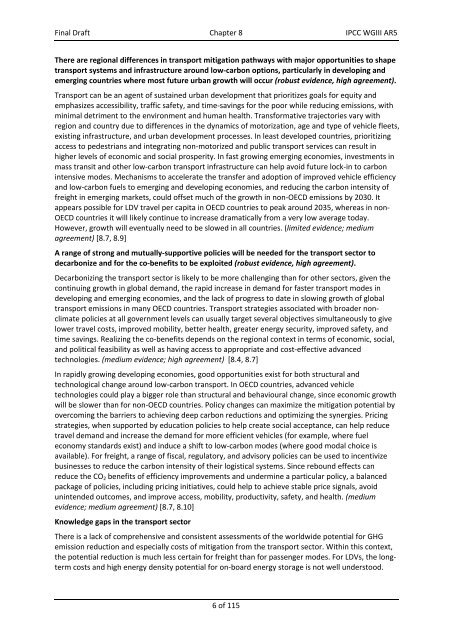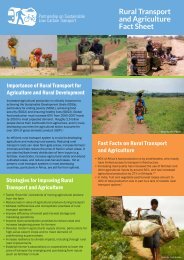ipcc_wg3_ar5_final-draft_postplenary_chapter8
ipcc_wg3_ar5_final-draft_postplenary_chapter8
ipcc_wg3_ar5_final-draft_postplenary_chapter8
Create successful ePaper yourself
Turn your PDF publications into a flip-book with our unique Google optimized e-Paper software.
Final Draft Chapter 8 IPCC WGIII AR5<br />
There are regional differences in transport mitigation pathways with major opportunities to shape<br />
transport systems and infrastructure around low‐carbon options, particularly in developing and<br />
emerging countries where most future urban growth will occur (robust evidence, high agreement).<br />
Transport can be an agent of sustained urban development that prioritizes goals for equity and<br />
emphasizes accessibility, traffic safety, and time‐savings for the poor while reducing emissions, with<br />
minimal detriment to the environment and human health. Transformative trajectories vary with<br />
region and country due to differences in the dynamics of motorization, age and type of vehicle fleets,<br />
existing infrastructure, and urban development processes. In least developed countries, prioritizing<br />
access to pedestrians and integrating non‐motorized and public transport services can result in<br />
higher levels of economic and social prosperity. In fast growing emerging economies, investments in<br />
mass transit and other low‐carbon transport infrastructure can help avoid future lock‐in to carbon<br />
intensive modes. Mechanisms to accelerate the transfer and adoption of improved vehicle efficiency<br />
and low‐carbon fuels to emerging and developing economies, and reducing the carbon intensity of<br />
freight in emerging markets, could offset much of the growth in non‐OECD emissions by 2030. It<br />
appears possible for LDV travel per capita in OECD countries to peak around 2035, whereas in non‐<br />
OECD countries it will likely continue to increase dramatically from a very low average today.<br />
However, growth will eventually need to be slowed in all countries. (limited evidence; medium<br />
agreement) [8.7, 8.9]<br />
A range of strong and mutually‐supportive policies will be needed for the transport sector to<br />
decarbonize and for the co‐benefits to be exploited (robust evidence, high agreement).<br />
Decarbonizing the transport sector is likely to be more challenging than for other sectors, given the<br />
continuing growth in global demand, the rapid increase in demand for faster transport modes in<br />
developing and emerging economies, and the lack of progress to date in slowing growth of global<br />
transport emissions in many OECD countries. Transport strategies associated with broader nonclimate<br />
policies at all government levels can usually target several objectives simultaneously to give<br />
lower travel costs, improved mobility, better health, greater energy security, improved safety, and<br />
time savings. Realizing the co‐benefits depends on the regional context in terms of economic, social,<br />
and political feasibility as well as having access to appropriate and cost‐effective advanced<br />
technologies. (medium evidence; high agreement) [8.4, 8.7]<br />
In rapidly growing developing economies, good opportunities exist for both structural and<br />
technological change around low‐carbon transport. In OECD countries, advanced vehicle<br />
technologies could play a bigger role than structural and behavioural change, since economic growth<br />
will be slower than for non‐OECD countries. Policy changes can maximize the mitigation potential by<br />
overcoming the barriers to achieving deep carbon reductions and optimizing the synergies. Pricing<br />
strategies, when supported by education policies to help create social acceptance, can help reduce<br />
travel demand and increase the demand for more efficient vehicles (for example, where fuel<br />
economy standards exist) and induce a shift to low‐carbon modes (where good modal choice is<br />
available). For freight, a range of fiscal, regulatory, and advisory policies can be used to incentivize<br />
businesses to reduce the carbon intensity of their logistical systems. Since rebound effects can<br />
reduce the CO 2 benefits of efficiency improvements and undermine a particular policy, a balanced<br />
package of policies, including pricing initiatives, could help to achieve stable price signals, avoid<br />
unintended outcomes, and improve access, mobility, productivity, safety, and health. (medium<br />
evidence; medium agreement) [8.7, 8.10]<br />
Knowledge gaps in the transport sector<br />
There is a lack of comprehensive and consistent assessments of the worldwide potential for GHG<br />
emission reduction and especially costs of mitigation from the transport sector. Within this context,<br />
the potential reduction is much less certain for freight than for passenger modes. For LDVs, the longterm<br />
costs and high energy density potential for on‐board energy storage is not well understood.<br />
6 of 115



